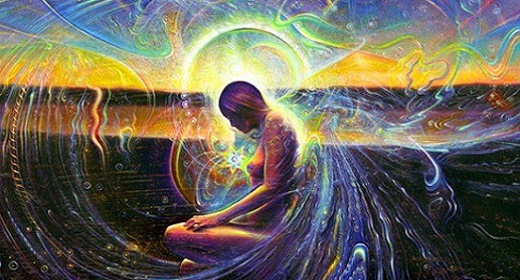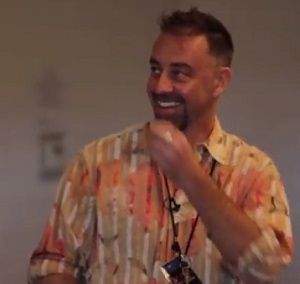by Gary S. Bobroff: “Where love rules there is no will to power.”– C. G. Jung

You notice a funny thing when you look at the evidence for the extension of consciousness–the mind operating beyond the body: the presence of feeling. Throughout the results of scientific experiments with people and animals looking at telepathy or other similar phenomenon, emotion is a discernible quality.
The Evidence highlights Emotion
Biologist Rupert Sheldrake (who loves designing scientific experiments to challenge the skeptical prejudices of his colleagues) has shown: that some dogs do know when their owners are coming home and demonstrate it on video; that people can feel when being stared at 60% of the time (watch the discussion with Morgan Freeman here); that telephone telepathy, knowing who’s calling, happens more often with people we’re emotionally close to (here); that family members demonstrate above average ability at card-guessing with each other, and that twins are best at it–and ironically those who don’t believe it’s possible score below average [here]!
Throughout each of these, emotion plays a role: dogs are emotionally connected to their owners and excited for their return, we feel creeped out by being stared at, and people that are close emotionally are far more likely to have an experience of consciousness as a shared field.
Feelings in Synchronicity
Both Sheldrake and the pioneering Swiss psychologist C. G. Jung noticed the statistical reality of ‘beginner’s luck’ and that with the loss of emotion came a change of luck: “a certain affective condition seems to be indispensable.” And as with beginner’s luck, feeling (whether it is conscious or unconscious) also seems to be an indispensable condition for synchronicity. Synchronicities are moments where outer events and inner states come together in meaningful parallels that are too explicit to explain away: we were just talking about someone and they call us; we break up with someone and we run into them all over town; we feel it in our heart when someone we love needs us, or is in danger; and visions of a relative who just has passed away are surprisingly common. So often at the center of those experiences is a big wad of authentic bodily–experienced feelings: love, hate, care, yearning, longing, wanting, wanting to protect. Our heartstrings seem to be the pathways that draw these experiences into our lives.
How can we understand the presence of emotion in the mystery of the extension of consciousness? To do so means radically reconsidering the way we understand our world; it might mean having to give up what you think you know. Our culture teaches us to pride ourselves on always having the right answers and leaves us ill-prepared for handling something that challenges us entirely. But previous cultures were able to consciously recognize this quality of the world and they designed whole systems of living around them.
Ancient Chinese Secret
To the culture in ancient China that produced the I Ching and the philosophy of Taoism, the world was a field in which our sincerity and inner state was tied in with the flow of events in the outer world. Taoism means “the way,” “the way of Nature,” and to this culture, synchronicity was an obviously present reality. They knew for themselves that by reflecting and working with our inner emotional truth, we became better able to move with the Nature’s flow.
“The art of life is more like navigation than warfare, for what is important is to understand the winds, the tides, the currents, the seasons, and the principles of growth and decay, so that one’s actions may use them and not fight them.”
– Alan Watts
Today our culture can consciously recognize this force. But it requires breaking through the overly-Masculine bias in us that has us reflexively seeing the world as a collection of objects, rather than as a “communion of subjects” (Thomas Berry). Synchronicity means that sometimes the world is the subject and we are the object. The Chinese saw this inter-subjectivity as living in Nature and the world as a balance of Yin and Yang, Feminine and Masculine and the metaphor of the sacred marriage is an especially appropriate one for our time. Today our dried-out, over-rational and too-linear Masculine consciousness is being winked at by something mysterious, curving and purposive–a force responding to our feeling connections with each other and breathing new meaning into our leaves. This archetypally Feminine energy is a mystery to us because we’re used to seeing the world through a Masculine lens of over-simplifications:
“As a rule the specialist’s is a purely masculine mind, an intellect to which fecundity is an alien and unnatural process; it is therefore an especially ill-adapted tool for giving rebirth to a foreign spirit. But a larger mind bears the stamp of the feminine; it is endowed with a receptive and fruitful womb which can reshape what is strange and give it a familiar form.”
– C. G. Jung, Introduction to The Secret of the Golden Flower
Synchronicity calls us to exercise the “fruitful womb” inside ourselves: to hold such experiences in our mind is one thing, to hold them in our heart is something else. In this way, it falls to us to bring this wedding into being in our time, to birth the new energy, to come to embody the archetypal Feminine in the world and know in our hearts that “where love rules there is no will to power.”
When we come together to explore this new view and the questions that it brings, I invite you to consider that many of the answers may lie somewhere that you don’t expect. It is beautiful and satisfying, and even world-changing, to realize that Nature responds to the feeling connections we make with each other; we are living in a heart-shaped world! However it is something even more to be that heart! Peace.
 Gary S. Bobroff is an international speaker, author and workshop leader. He delivers the depth of Jungian approaches in a visual, accessible and engaging form. He is the developer and facilitator of Archetypal Nature and the founder of JungianOnline.com
Gary S. Bobroff is an international speaker, author and workshop leader. He delivers the depth of Jungian approaches in a visual, accessible and engaging form. He is the developer and facilitator of Archetypal Nature and the founder of JungianOnline.com









































